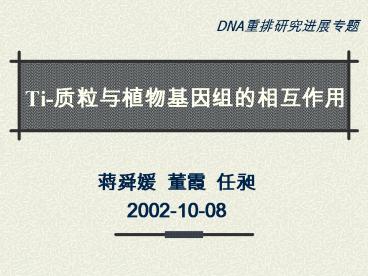Ti-????????????? - PowerPoint PPT Presentation
1 / 20
Title: Ti-?????????????
1
Ti-?????????????
DNA????????
- ??? ?? ??
- 2002-10-08
2
What is Ti-plasmid?
- Ti-plasmid, (short for tumor-inducing
plasmid)is a large (150200 kb) double-stranded
circular DNA plasmid in a soil bacterium called
Agrobacterium tumefaciens, which causes what is
known as produces uncontrolled growths (tumors,
or galls), normally at the base (crown) of the
plant. Ti-plasmid is the key to this tumor
production.
3
Figure 1. In the process of causing crown gall
disease, the bacterium Agrobacterium tumefaciens
inserts a part of its Ti plasmida region called
T-DNAinto a chromosome of the host plant.
4
Figure 2. Simplified representation of the major
regions of the Ti plasmid of A. tumefaciens. The
T-DNA, when inserted into the chromosomal DNA of
the host plant, directs the synthesis of
nopaline, which is then utilized by the bacterium
for its own purposes. T-DNA also directs the
plant cell to divide in an uncontrolled manner,
producing a tumor.
5
Structure of Ti-plasmid
- T-DNA?
- ??? (Vir-region, vir)
- ?????? (Origin of replication, ori)
- ???????? (Transfer
function site, tra) - ??????? (ocs or nos)
6
Two types of Ti-plasmid
- OCS plasmid (octopine )
- pTiAch5, pTiA6NC, pTiB653, pTiAg162
- NOS plasmid (nopaline )
- pTiT37, pTiT38
7
?????-??DNA??????
- ????????????????
- ??????????????
- T-DNA????T?????
- T?????????????????????
- T-DNA?????????
8
Figure 1. In the process of causing crown gall
disease, the bacterium Agrobacterium tumefaciens
inserts a part of its Ti plasmida region called
T-DNAinto a chromosome of the host plant.
9
Interaction of Agrobacterium Ti-plasmid DNA and
plant cells????????????????
- ?????????????????????
- ???????????????????????????Ti????????
- ?????(AS),a-???????
10
Ti??????????T-DNA?????
- Insert picture
11
Integration of T-DNA into the chromosome of host
plant T-DNA?????????
- ??????DNA???????(nick)
- ??DNA??,?????53?????????????(gap)
- T-DNA????,????DNA??????????????????
- T-DNA?????????????,T-DNA??DNA????
- ?DNA??????,?????T-DNA???????T-DNA?????,???????
12
References via NCBI
- The interaction of Agrobacterium Ti-plasmid DNA
and plant cells (1980) - Transgene integration in aspen structures of
integration sites and mechanism of T-DNA
integration. (2002) - How does the T-DNA of Agrobacterium tumefaciens
find its way into the plant cell nucleus? (1993) - T-DNA integration a mode of illegitimate
recombination in plants. (1991) - Transfer and Integration of T-DNA without Cell
Injury in the Host Plant. (1997) - Integration of Agrobacterium T-DNA into a tobacco
chromosome possible involvement of DNA homology
between T-DNA and plant DNA. (1990) - Illegitimate recombination in plants a model for
T-DNA integration. (1991) - DNA rearrangement associated with the integration
of T-DNA in tobacco an example for multiple
duplications of DNA around the integration
target. (1995) - The DNA sequences of T-DNA junctions suggest that
complex T-DNA loci are formed by a recombination
process resembling T-DNA integration. (1999) - Two different but related mechanisms are used in
plants for the repair of genomic double-strand
breaks by homologous recombination. (1996)
13
Production of transgenic plants with recombinant
Ti-plasmid
- Formation of Cointegrate Ti-plasmid
- Generation of a transgenetic plant via the growth
of a cell transformed by T-DNA
14
Figure 3. (a) To produce transgenic plants, an
intermediate vector of manageable size is used to
clone the segment of interest. In the method
shown here, the intermediate vector is then
recombined with an attenuated (disarmed) Ti
plasmid to generate a cointegrate structure
bearing the insert of interest and a selectable
plant kanamycin-resistance marker between the
T-DNA borders, which is all the T-DNA that is
necessary to promote insertion. (b) The
generation of a transgenic plant through the
growth of a cell transformed by T-DNA.
15
Formation of Cointegrate Ti-plasmid
- Attenuate the natural Ti-plasmid.
- have the entire right-hand region of its T-DNA,
including tumor genes and nopaline-synthesis
genes deleted, rendering it incapable of tumor
formation. - Prepare a intermediate vector.
- Incorporate the intermediate vector.
16
Fig 3.(a) To produce transgenic plants, an
intermediate vector of manageable size is used to
clone the segment of interest. In the method
shown here, the intermediate vector is then
recombined with an attenuated (disarmed) Ti
plasmid to generate a cointegrate structure
bearing the insert of interest and a selectable
plant kanamycin-resistance marker between the
T-DNA borders, which is all the T-DNA that is
necessary to promote insertion.
17
Generation of a transgenetic plant via the growth
of a cell transformed by T-DNA
- Bacterial infection
?transformed plant cell - Cell culturation ? callus
- Inducing the differentiation of shoots and roots,
and transferring to soil
? transgenetic plant
18
Fig.3 (b) The generation of a transgenic plant
through the growth of a cell transformed by
T-DNA.
infection
19
Figure 4. T-DNA and any DNA contained within it
are inserted into a plant chromosome in the
transgenic plant and then transmitted in a
Mendelian pattern of inheritance.
20
Via NCBI, from
- Modern Genetic Analysis
- 11. Applications of Recombination DNA Technology
- Recombinant DNA Technology in Eukaryotes
- Molecular Cell Biology
- 8. Genetic Analysis in Cell Biology
- 8.5 Gene Replacement and Transgenic Animals
21
The End
- Thanks!































